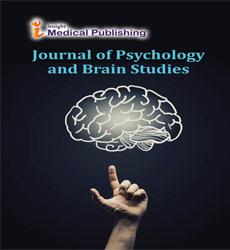A Note on Anxiety Disorders in Children
Sushree Sunena*
Department of Psychology, Utkal University, Bhubaneswar, Odisha, India
- *Corresponding Author:
- Sushree Sunena
Department of Psychology
Utkal University, Bhubaneswar, Odisha, India
E-mail: sushreesunena04@gmail.com
Received Date: October 07, 2021; Accepted Date: October 21, 2021; Published Date: October 28, 2021
Citation: Sunena S (2021) A Note on Anxiety Disorders in Children. J Psychol Brain Stud Vol.5 No.10:47.
Comorbid psychiatric disorders are a significant source of increased impairment and dysfunction in autism spectrum disorders (ASD). In a recent structured interview research, 72 percent of children with high-functioning autism had at least one other psychiatric condition, with particular phobia (44 percent), obsessive–compulsive disorder (37 percent), ADHD (30.6 percent), and major depression being the most common diagnoses. Anxiety disorders are recognised as a major cause of extra impairment in ASD symptoms, with estimates of comorbid anxiety symptoms reaching up to 84 percent. To increase clinical abilities to diagnose and treat anxiety in ASD, sensitive and specific measurements of anxiety in a brief clinical format are required.
Despite the high frequency, doctors frequently struggle to diagnose anxiety disorders in children with ASD. First, it is unclear whether anxiety disorder and ASD are distinct conditions or if anxiety symptoms are a component of the fundamental criteria of ASD. Anxiety symptoms might manifest as non-specific actions or as an increase in repetitive behaviours. Second, self-reports in ASD youth may be inconclusive due to issues with emotional insight or the ability to appropriately define and report one's emotions.
Many autistic youth struggle to comprehend and articulate their inner experiences and emotional language in detail. Relying on parent reports may also be problematic because, in general, parents and children with ASD do not exhibit a good link in their anxiety levels. Third, kids with ASD who have aberrant behaviours and co-occurring mental problems are more likely to be treated with polypharmacy of psychotropic medications. Because young people with ASD have a high rate of medical comorbidity, such as seizures, efforts to improve the accuracy of concomitant psychiatric problems can lead to more targeted and safer therapies.
A clinically effective and accurate instrument for assessing anxiety in ASD is a critical step toward improving this population's ability to identify problems and monitor outcomes. The Screen for Child Anxiety-Related Emotional Disorders is a well-known anxiety screening instrument for adolescents. The SCARED is a 41-item parent- and child-report scale that is free to download, simple to administer, and delivers a summary score of anxiety symptoms. There was a high level of internal consistency and correlation with structured interviews. It also yields encouraging effects when used to youngsters with ASD. With organised clinical interviews in ASD, both the European and American versions of the SCARED demonstrate strong internal reliability and convergent validity.
Across a wide range of scales, the SCARED-child and SCARED- parent forms show a substantial association with the CBCL and YSR. The CBCL and YSR syndrome scales for anxious/depressed children and parents showed the strongest correlation and strongly predicted both child and parent SCARED scores, indicating some convergence across the instruments. Anxiety in ASD can be categorised into internalising and externalising characteristics as measured by the CBCL. Externalizing behavioural symptoms in children with ASD may be misinterpreted by parents as signals of anxiousness.
The CBCL broadband scale of externalising difficulties was strongly linked with both child and parent perceptions of anxiety and the degree of association between the two was the highest. Internalizing and externalising symptoms occur in the ASD community, increasing dysfunction and decreasing quality of life and leading to intervention targets. With the release of the DSM- 5, it is now feasible to officially identify comorbid illnesses with ASD; therefore it is critical to obtain a better knowledge of the dimensional nature of other conditions that may be present, such as anxiety and ADHD. More research on the rating behaviour of parents of children with ASD and children with ASD is needed, and the use of the SCARED to detect anxiety in ASD should be supplemented with other measures and techniques.
Open Access Journals
- Aquaculture & Veterinary Science
- Chemistry & Chemical Sciences
- Clinical Sciences
- Engineering
- General Science
- Genetics & Molecular Biology
- Health Care & Nursing
- Immunology & Microbiology
- Materials Science
- Mathematics & Physics
- Medical Sciences
- Neurology & Psychiatry
- Oncology & Cancer Science
- Pharmaceutical Sciences
